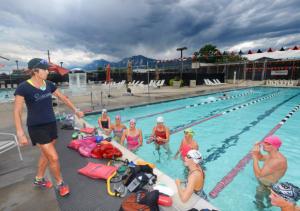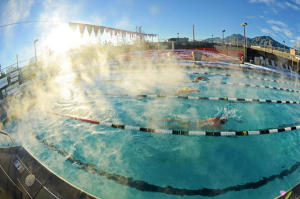The Human Eel. That’s what we’ll call this horror movie. You are the star, snaking your way through the pool.
You didn’t know you were an eel! You and I found it out together when we bound your ankles! We’ve spent some weeks talking about this and this is the last week I’m going to belabor the point, but I’m going to add one more thing to nag you about: We’ll look at what you do from the neck up. Next week we are going to move to some other themes.
Learning to swim as an adult is a psychological exercise. So much of your technique is born of trauma: specifically, the fear of death by lack of oxygen. For so many swimmers the act of breathing, and the fear of not being able to breathe, has exerted an overpowering influence on how you swim. What I’m talking about are two behaviors, or urges.

First is the urge to just pull your head straight up to breathe, like a prairie dog popping his head out of his hole. For some of you, this never quite leaves, and regardless how much lipstick you slather all over your stroke, there are vestiges of this fear that remain.
Just watch swimmers who're just learning. They invariably pull their heads straight up, and look forward, and only then turn their heads to the side.
I suspect you suffer from the vestigial remains of this if I see the water hitting your forehead right about eyebrow line. Yes, you breathe to the side, but you never quite got the hang of looking straight down in between breaths. Way back on your brain stem sits that fear of drowning.
But this head posture sinks your feet. Also, if I want you to turn your head to the side, one goggle cup still in the water, mouth angled back toward the shoulder, breathing in that little hollow airspace your head forms, that small maneuver to breathe is much easier if the water is hitting you at the top of the forehead instead of at the eyebrow.
The second thing you do, subconsciously, is make a big production out of the act of taking a breath. You bend at the waist, twist your torso, to make golldanged sure that you get that breath of air. This pulls you out of balance, out of line, and you must splay your legs or engage in some other gymnastic to keep yourself in line. When your legs are banded these things you do are exposed.
I’ve insulted you! You are affronted by the idea that your stroke problems are a consequence of the fear of the water! I acknowledge that you really are not afraid anymore. I concur that you breathe to the side. Still, you retain these vestigial behaviors from the time you were still struggling with learning to breathe to the side. The fact that we don’t have to deal with your fear means we only have to deal with the mechanics influenced by a long-forgotten fear.
Here's what one Guppy wrote in the forum thread on the Guppy Challenge: "I finally got a band and it has made a big difference. I've been doing the skill set just holding the buoy between my ankles. Now that I have the band and the buoy I can really see that I am fishtailing. When I just had the buoy I didn't realize it, maybe because I was too focused on holding the buoy in place?"
TYR and Finis make ankle buoys. Alternatively, a standard swim buoy will work, but these all work best if you have an exercise band holding everything together.

A center-mount snorkel will help you focus on keeping your head down, and also show you what a symmetric stroke feels like. You have no excuse, while swimming with a snorkel, to not swim with a 6-beat kick (3 kicks for every arm pull). No excuse not to swim with your hands hitting the water directly in front of each shoulder. No excuse why you shouldn’t pull your chin a bit more toward your chest while in between breaths. If you’re having trouble with these swim elements, get yourself a swim snorkel.
Here is a video of Michael Phelps' freestyle. Note in particular how his hands enter the water directly in front of each shoulder, and he has a completely symmetric kick.
When you swim next week’s final workout you’re halfway finished with the Guppy Challenge. We’ve spent a lot of time focused on swimming straight ahead, without extraneous movements taking you side to side (The Human Eel). Let’s add to that making sure that you swim on the surface, from your fingertip to big toe. Your head position in the water (looking down instead of forward) is going to help you in both planes.
When you kick, I want your feet to break the surface. "Make bubbles." Look at Phelps’ feet when he kicks. Your feet don’t have to come entirely out of the water, but I want the heels, at least, to break the surface. Just, you know, make your stroke look exactly like Michael’s stroke ;-)
Guppy Challenge, Week-4, Workout-1
Warm-up => 6x50yd freestyle.
Style set => 4x100yd w/bound ankles.
Main set =>
GUPPIES => 2 x (3 x 150yd, then after the last 150 you kick a 50). (In other words, a 500yd set, rest a minute, do it again, 1000yd total.)
TARPONS => 3 x (3 x 150yd, then after the last 150 you kick a 50).
TUNAS => 4 x (3 x 150yd, then after the last 150 you kick a 50).
Warm-down => 200yd, easy, alternate freestyle and “stroke”. “Stroke” in swimming that’s parlance for anything other than freestyle (backstroke, breaststroke, butterfly).
Total Guppy yards this workout: 1900
—
Guppy Challenge, Week-4, Workout-2
Warm-up => 6x50yd freestyle.
Main set =>
It’s a Fifties Party! Take a guess what interval you need if you’re going to do a bunch of 50s with 8sec rest between.
GUPPIES => 30x50yd swim (don’t start too fast!)
TARPONS => 40x50yd swim
TUNAS => 50x50yd swim
Warm-down => 200yd, easy. Some stroke is okay.
Total Guppy yards this workout: 2000
—
Guppy Challenge, Week-4, Workout-3
Warm-up => 6 x 50yd freestyle.
Style set => 2 x 100yd 1-arm pulls followed by 50 kick; rest a minute, do it again (500yd total)
Main set =>
GUPPIES => 500yd, stiff (but evenly-paced) effort; rest 2min, 8x100 at an ambitious interval
TARPONS => 500yd, stiff (but evenly-paced) effort; rest 2min, 10x100 at an ambitious interval
TUNAS => 500yd, stiff (but evenly-paced) effort; rest 2min, 12x100 at an ambitious interval
Warm-down => 100 easy.
Total Guppy yards this workout: 2200
— EXTRA CREDIT! —
Guppy Challenge, Week-4, Workout-4 Extra Credit!
Warm-up:
=> 6x50yd freestyle
Style set:
=> 8x50yd w/banded ankles: first 25 the goal is to take the fewest number of strokes to get across the pool; return with a strong freestyle.
Main set:
GUPPIES => down-ladder: 4x100, hard swim, short rest, kick a 50. 3x100, kick a 50, 2x100, kick a 50. 100yd hard, kick a 50.
TARPONS & TUNAS => down-ladder: 5x100, 4x100, 3x100, 2x100, with a 50 kick after each.
Warm-down:
=> 100yd, easy, alternate freestyle and “stroke”.
Total Guppy yards this workout: 2000
—
Guppy Challenge, Week-4, Workout-5 Double Extra Credit!
Warm-up => 4 x 50yd freestyle.
Style set 1 => 2 x (100yd 1-arm pull - focus on off-arm! - followed by 50 kick (300yd total)
Style set 2 => 6 x 50yd bound ankles
Main set =>
GUPPIES => 6 x 200yd See if you can lower your swim interval. Try to do these on short rest (10sec or less)
TARPONS => 8 x 200yd
TUNAS => 10 x 200yd
Warm-down => 100yd: first 50 very slow, second 50 normal, then repeat. Were the “slow” 50s easier to swim, easier to maintain form, than earlier in the workout?
Total Guppy yards this workout: 2100
—
Total weekly GUPPY yardage
If you do the first 3 workouts: 6100yd
These plus the 4th workout: 8100yd
All 5 workouts: 10,200yd
—
Dryland Alternative
Here's a dryland alternative to any of these workouts above. If you've got a swim bench, a Vasa Ergometer (or Vasa Trainer, or similar land-based trainer):
50 strokes (a pull with one arm is one stroke in my parlance, so, 20 cycles). Start easy! The fatigue comes on you quicker than you think. Rest 30sec. Repeat this 10 times. Rest 5 minutes. Then...
30 strokes x 10 with 20sec rest in between.



